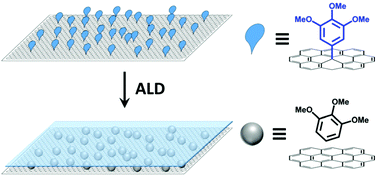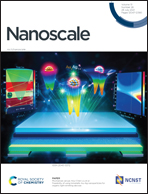A chemisorbed interfacial layer for seeding atomic layer deposition on graphite†
Abstract
The integration of graphene, and more broadly two-dimensional materials, into devices and hybrid materials often requires the deposition of thin films on their usually inert surface. As a result, strategies for the introduction of surface reactive sites have been developed but currently pose a dilemma between robustness and preservation of the graphene properties. A method is reported here for covalently modifying graphitic surfaces, introducing functional groups that act as reactive sites for the growth of high quality dielectric layers. Aryl diazonium species containing tri-methoxy groups are covalently bonded (grafted) to highly oriented pyrolytic graphite (HOPG) and graphene, acting as seeding species for atomic layer deposition (ALD) of Al2O3, a high-κ dielectric material. A smooth and uniform dielectric film growth is confirmed by scanning electron microscopy (SEM), atomic force microscopy (AFM) and electrical measurements. Raman spectroscopy showed that the aryl groups gradually detach from the graphitic surface during the Al2O3 ALD process at 150 °C, with the surface reverting back to the original sp2-hybridized state and without damaging the dielectric layer. Thus, the grafted aryl groups can act as a sacrificial seeding layer after healing the defects of the graphitic surface with annealing treatment.



 Please wait while we load your content...
Please wait while we load your content...